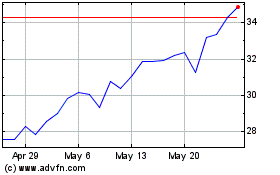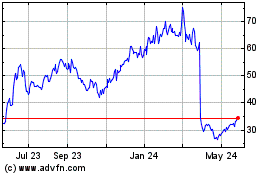Disc Medicine, Inc. (NASDAQ:IRON), a clinical-stage
biopharmaceutical company focused on the discovery, development,
and commercialization of novel treatments for patients suffering
from serious hematologic diseases, today announced positive
additional data for bitopertin in erythropoietic protoporphyria
(EPP), including additional analyses of AURORA data that further
demonstrated the clinical activity of bitopertin and highlighted
meaningful improvements in light tolerance, phototoxic reactions,
and quality of life. Additionally, Disc shared updated data from a
Phase 1b trial of DISC-0974 in MF anemia which demonstrated durable
increases in hemoglobin and reduced transfusion burden in a
majority of evaluable patients. Disc also shared initial SAD data
from a Phase 1 healthy volunteer trial of DISC-3405 that provided
proof of mechanism, showing that the drug has the potential to
provide deep and sustained increases in hepcidin and reductions in
iron. The data were presented at the European Hematology
Association (EHA) 2024 Congress.
“This has been a tremendously exciting EHA meeting for Disc,
where we had the opportunity to present data from ongoing clinical
studies across our entire portfolio, showcasing the activity and
therapeutic potential of each of our programs,” said John Quisel,
J.D., Ph.D., President and Chief Executive Officer of Disc. “At
this meeting, we shared a deeper analysis of data from AURORA that
underscores our confidence in bitopertin’s potential in EPP and
supports a development path forward. We also provided an update
from our study of DISC-0974 in anemia of myelofibrosis, which
continues to demonstrate promising hematologic activity similar to
what we showed at ASH. And, finally, we’re excited to share for the
first time, data from our third program, DISC-3405, in healthy
volunteers, demonstrating clinical proof-of-mechanism as an iron
restriction agent with the potential for a differentiated
profile.”
Bitopertin in EPP
The AURORA study is a randomized, double-blind,
placebo-controlled Phase 2 clinical trial that enrolled 75 adult
subjects with EPP. Subjects were randomized 1:1:1 to receive 20 mg
of bitopertin (n=26), 60 mg of bitopertin (n=25), or placebo (n=24)
once daily for 17 weeks. Key AURORA data presented include:
- Significant reductions in protoporphyrin IX (PPIX) (40% for the
60 mg group) compared to placebo
- Meaningful improvements on key aspects of EPP
- Time-dependent improvement in light tolerance that was
nominally significant compared to placebo in both the 20 mg
(p=0.026) and 60 mg (p=0.013) dose groups
- ~2x improvement in light tolerance relative to baseline in both
20 mg and 60 mg dose groups as evaluated in a post-hoc longitudinal
analysis
- Substantial, dose-dependent reductions in rate of phototoxic
reactions compared to placebo, reaching statistical significance in
the 60 mg dose group (75.3% reduction, p=0.011)
- Dose-dependent improvements in Patient Global Impression of
Change (PGIC), which were statistically significant for the 60 mg
dose (p=0.022)
- Evaluation of the time course of phototoxic reactions and
sunlight exposure showed greater treatment effect in the time
period after PPIX nadir was reached, including elimination of
observed phototoxic reactions in the 60 mg dose group
- Greater PPIX reductions were associated with improvements in
multiple light tolerance measures, including cumulative total time
in light, average time in sunlight without pain, change from
baseline in time to prodrome, as well as PGIC
- Bitopertin was generally well-tolerated with no reported
serious adverse events (SAEs) to date
- Disc also presented the full adult data set from BEACON, which
was consistent with previously-presented results and demonstrated
similar clinical activity to that observed in AURORA
DISC-0974 in MF
The Phase 1b/2a multi-center, open-label, ascending-dose
clinical trial of DISC-0974 is enrolling patients with MF and
severe anemia, including both transfusion and non-transfusion
dependent patients. In the phase 1b dose-escalation phase,
DISC-0974 is administered subcutaneously every 4 weeks for up to 6
treatments. Updated data from 34 patients with an April 29, 2024
cutoff include:
- Substantial and sustained reductions in hepcidin levels and
increases in iron were observed in patients for several weeks after
each dose
- Strong hematologic response was observed across all patient
types at 28-100 mg doses:
- 68.9% of non-transfusion dependent (nTD) participants
demonstrated a hemoglobin response of ≥1.5 g/dL (n=29)
- 60% of nTD participants who have completed at least 16 weeks of
treatment had a mean hemoglobin response of ≥1.5 g/dL above
baseline sustained for at least 12 weeks (n=15)
- One of two evaluable transfusion dependent (TD) participants
became transfusion independent (TI) by the end of the trial
- Hemoglobin response of ≥1.5 g/dL above baseline was achieved in
6 of 10 participants with concomitant JAK
inhibitor therapy
- All evaluable participants with baseline transfusion
requirements demonstrated at least a 50% reduction in transfusions
over a rolling 8-week window on trial compared to baseline
(n=8)
- DISC-0974 was generally well-tolerated at all evaluated dose
levels
DISC-3405
Initial data were also presented from the SAD portion of the
Phase 1 clinical trial of DISC-3405 in healthy volunteers. In this
trial, healthy males and females ages 18 to 65 were given a single
dose of placebo (n=10) or DISC-3405 at 75 mg intravenously (IV)
(n=6), 37.5 mg subcutaneously (SC) (n=6), 75 mg SC (n=6), 150 mg SC
(n=6), or 300 mg SC (n=6). This initial data showed:
- A meaningful dose-dependent increase in hepcidin and
corresponding reduction in serum iron across all dose levels
- Mean serum iron reduction in excess of 50% from baseline was
achieved in the150- and 300-mg dose groups
- Mean serum iron reduction in excess of 50% was sustained for at
least 4 weeks for the 300-mg dose group, with meaningful reduction
observed in selective hematological parameters (CHr, hemoglobin,
and hematocrit)
- PK/PD profile is supportive of monthly subcutaneous
dosing.
- DISC-3405 was generally well-tolerated with no SAEs, AEs higher
than Grade 2, or AEs leading to trial withdrawal reported to
date
Management will host a call to review the presented data on
Friday, June 14th at 8:00 am ET. Please register for the event on
the Events and Presentations page of Disc’s website
(https://ir.discmedicine.com/).
Bitopertin, DISC-0974, and DISC-3405 are investigational agents
and are not approved for use as therapies in any jurisdiction
worldwide.
About Disc Medicine
Disc Medicine is a clinical-stage biopharmaceutical company
committed to discovering, developing, and commercializing novel
treatments for patients who suffer from serious hematologic
diseases. We are building a portfolio of innovative, potentially
first-in-class therapeutic candidates that aim to address a wide
spectrum of hematologic diseases by targeting fundamental
biological pathways of red blood cell biology, specifically heme
biosynthesis and iron homeostasis. For more information, please
visit www.discmedicine.com.
Disc Medicine Cautionary Statement Regarding
Forward-Looking Statements
This press release contains “forward-looking statements” within
the meaning of the Private Securities Litigation Reform Act of
1995, including, but not limited to, express or implied statements
regarding Disc’s expectations with respect to its AURORA Phase 2
and BEACON Phase 2 clinical trials of bitopertin and the results
thereof, its Phase 1b/2 clinical trial of DISC-0974 in patients
with MF and NDD-CKD patients with anemia, its initial SAD data in
its Phase 1 clinical trial of DISC-3405 in healthy volunteers; and
projected timelines for the initiation and completion of its
clinical trials, anticipated timing of release of data, and other
clinical activities. The use of words such as, but not limited to,
“believe,” “expect,” “estimate,” “project,” “intend,” “future,”
“potential,” “continue,” “may,” “might,” “plan,” “will,” “should,”
“seek,” “anticipate,” or “could” or the negative of these terms and
other similar words or expressions that are intended to identify
forward-looking statements. Forward-looking statements are neither
historical facts nor assurances of future performance. Instead,
they are based on Disc’s current beliefs, expectations and
assumptions regarding the future of Disc’s business, future plans
and strategies, clinical results and other future conditions. New
risks and uncertainties may emerge from time to time, and it is not
possible to predict all risks and uncertainties. No representations
or warranties (expressed or implied) are made about the accuracy of
any such forward-looking statements.
Disc may not actually achieve the plans, intentions or
expectations disclosed in these forward-looking statements, and
investors should not place undue reliance on these forward-looking
statements. Actual results or events could differ materially from
the plans, intentions and expectations disclosed in the
forward-looking statements as a result of a number of material
risks and uncertainties including but not limited to: the adequacy
of Disc’s capital to support its future operations and its ability
to successfully initiate and complete clinical trials; the nature,
strategy and focus of Disc; the difficulty in predicting the time
and cost of development of Disc’s product candidates; Disc’s plans
to research, develop and commercialize its current and future
product candidates; the timing of initiation of Disc’s planned
preclinical studies and clinical trials; the timing of the
availability of data from Disc’s clinical trials; Disc’s ability to
identify additional product candidates with significant commercial
potential and to expand its pipeline in hematological diseases; the
timing and anticipated results of Disc’s preclinical studies and
clinical trials and the risk that the results of Disc’s preclinical
studies and clinical trials may not be predictive of future results
in connection with future studies or clinical trials and may not
support further development and marketing approval; the other risks
and uncertainties described in the “Risk Factors” section of our
Quarterly Report for the quarter ended March 31, 2024, and other
documents filed by Disc from time to time with the Securities and
Exchange Commission (SEC), as well as discussions of potential
risks, uncertainties, and other important factors in Disc’s
subsequent filings with the SEC. Any forward-looking statement
speaks only as of the date on which it was made. None of Disc, nor
its affiliates, advisors or representatives, undertake any
obligation to publicly update or revise any forward-looking
statement, whether as result of new information, future events or
otherwise, except as required by law.
Media Contact
Peg RusconiVerge Scientific
Communicationsprusconi@vergescientific.com
Investor Relations Contact
Christina TartagliaStern Investor
Relationschristina.tartaglia@sternir.com
Disc Medicine (NASDAQ:IRON)
Historical Stock Chart
From Jun 2024 to Jul 2024

Disc Medicine (NASDAQ:IRON)
Historical Stock Chart
From Jul 2023 to Jul 2024
